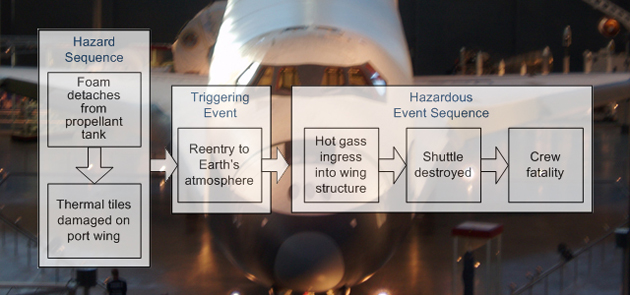Hazard
(Alias: hazardous situation, threat, imperilment)
There is no terror in a bang, only in the anticipation of it.
- Alfred Hitchcock
A hazard is a source of danger. It can come about through the presence of a physical condition, situation or series of events that have the potential for causing harm to people, property or the environment. International standards define hazards as follows:
- Potential source of harm1 ...
The term includes danger to persons arising within a short time scale (for example, fire and explosion) and also those that have a long term effect on a person's health (for example, release of a toxic substance).
- A physical situation with a potential for human injury2
- Any real or potential condition that can cause injury, illness, or death to
personnel; damage to or loss of a system, equipment or property; or damage to the environment3.
- Any situation that could contribute to an accident. Hazards should be eliminated wherever 'practicable', but this is not always the case. Where a hazard cannot be completely eliminated then there will be some risk4.
- A physical situation or state of a system, often following from some initiating event, that may lead to an accident5.
Note! |
An environment or a system can be in a hazardous state without an accident occurring; it is the potential for causing an accident that creates the hazard, not necessarily the actuality. |
Quantifing Hazards
Where possible, hazards should be quantified. For example, hazards can be expressed in units of dimension, volume, mass, velocity, momentum, power, energy, location, temperature and frequency of occurrence.
When a Hazard Becomes a Hazardous Event

Sources of Hazards
Hazards can arise from:
- The physical environment in which we find ourselves. For example, high winds on an elevated road bridge. Note that this hazard can be quantified in terms of wind speed.
- Dangerous failure of equipment we operate or to which we are exposed. For example, a set of traffic signals that display a green lamp to opposing flows of traffic.
- A sequence of unwanted events. For example (refer figure): the space shuttle Columbia is launched, a chunk of foam is shed from the main propellant tank, the chunk strikes the leading edge of the shuttle's port wing damaging one or more of the wing's thermal protection panels. This sequence of events created the hazard that was directly responsible for the following hazardous event: on reentry to the earth's atmosphere the damage allows hot gases to penetrate and destroy the internal wing structure and consequently the entire vehicle with the resultant loss of the crew.
Dealing With Hazards
If a hazard exists there is always a finite risk that it will progress to a hazardous event. International standards1,2,3,5 governing the development of safety related systems require a formal hazard analysis process to recognise and mitigate these risks.
Member Comments |
65 Comments |
45 member ratings |
|
✭ ✭ ✭ ✭ ✩
|
|

|


